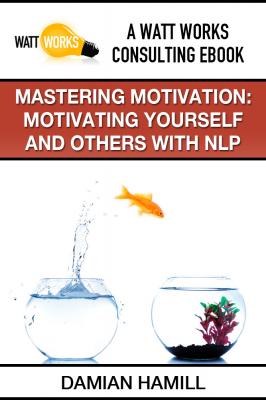ТОП просматриваемых книг сайта:
Mastering Motivation: Motivating Yourself and Others With NLP. Damian Inc. Hamill
Читать онлайн.Название Mastering Motivation: Motivating Yourself and Others With NLP
Год выпуска 0
isbn 9781456610418
Автор произведения Damian Inc. Hamill
Жанр Банковское дело
Издательство Ingram
Again, whatever the example of a demotivating experience you have been using - make a picture of it in your mind’s eye and we will explore the qualities of this picture too.
•Is the picture in colour or in black and white?
•Is it three dimensional or flat?
•Where are you in the picture? Can you see yourself in the event as if you are watching from the outside? Or are you viewing the experience as a participant – in your own skin, so to speak, and watching through your own eyes? Take a moment to check.
•I want you to notice how boundaried or expansive the image is. Is it a full, panoramic vista or does it have a frame or some sort of boundary that confines it?
•Let’s think about movement. Is the image a still picture or is there movement in it, like a motion picture?
•How far away from you is the picture? Close? Middle distance? Far off? If you could estimate a rough distance what would it be?
•Now think about its location. Is the image directly in front of you or off to the left or right? Is it higher than eye level or down below you? Or a combination of a number of these orientations?
•Now, I want you to notice its brightness. Is it a bright image or darker in nature?
•And finally, focus. Is the image sharply focussed or is it blurred, fuzzy or hazy?
If this has gone smoothly we should now have ‘calibrated’ – that is, measured the characteristics – of two very different states – motivated and de-motivated. We have investigated and recorded their physiology and we have explored the qualities of at least the visual aspects of how you represent the experiences in your own mind. There may have been sounds and other sensory awarenesses as well but let’s not be too ambitious for the moment.
Activity 4 – Comparing and Contrasting Your States
Let’s set the two lists side by side and compare them.
What do you notice? Where are they similar and where are they different?
Now, it’s quite likely that there will be differences between the two both in terms of physiology and the mental pictures you made.
First of all, look at the qualities of the mental pictures.
A number of the qualities of the motivating experience are likely to be different from those of the non-compelling one. For example, one experience might be in colour and the other black and white. One picture might be far off in the distance and the other up close. Many of the qualities may be similar and that’s fine, but it’s likely that there will be certain key qualities that are different.
If you have never explored this before this might come as a little bit of a surprise – hopefully a pleasant one – to realise that the way you represent different types of experiences have qualitative differences. It’s also likely that they will be consistent.
In other words, all motivating experiences are likely to have similar qualities to each other for you and all non-motivating or demoralising experiences are likely to be visually ‘coded’ in the same way. In NLP we called these subtle distinctions Sub-modalities.
Now, a question that might just be on your mind is this – if we swapped these ‘sub-modalities’ around, changed the characteristics of the demoralising experience to match those of the motivating experience, would we suddenly find ourselves more motivated?
It’s a good question and the answer is – very possibly. Indeed there are NLP exercises that suggest you do just that. We want to take a slightly more sophisticated approach, however.
We think that physiology and sub-modalities – the two components of any state – can be a useful snapshot of our degree of motivation at any point in time. For this reason it can be interesting to explore them as a form of measurement so to speak.
If we become more enthused about something that didn't used to inspire us, we can expect to find that the sub modalities of that experience change accordingly. However it's often not enough simply to try shifting our mental pictures around in the hope that our motivation will magically increase. Expecting such transformation to reliably happen is like expecting the psychological tail to wag the dog. Even if such a change occurred in the short term, it is unlikely that the sub-modality changes would stick unless some greater, more systemic change had taken place.
Конец ознакомительного фрагмента.
Текст предоставлен ООО «ЛитРес».
Прочитайте эту книгу целиком, купив полную легальную версию на ЛитРес.
Безопасно оплатить книгу можно банковской картой Visa, MasterCard, Maestro, со счета мобильного телефона, с платежного терминала, в салоне МТС или Связной, через PayPal, WebMoney, Яндекс.Деньги, QIWI Кошелек, бонусными картами или другим удобным Вам способом.

